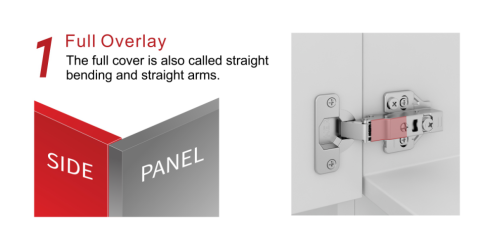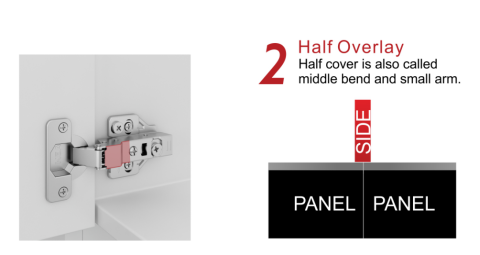When designing or renovating cabinets, cabinet door hinges are often one of the most easily overlooked yet crucial components. Although it may seem insignificant, the hinge not only determines the way the cabinet door opens and closes, but also the fit between the cabinet door and the cabinet frame.
Among the various hinge styles, overlay cabinet hinges are highly favored in both modern and traditional cabinet designs due to their aesthetic appeal and practicality. Understanding the differences between full overlay and half overlay hinges can help you create the ideal appearance and functionality of your cabinets.
What Is an Overlay Cabinet Hinge?
The term overlay refers to how much of the cabinet frame is covered by the cabinet door when it’s closed. Overlay hinges are used on framed cabinets, where the door sits on top of the face frame rather than inside it. The type of overlay determines how your cabinet doors fit and how much of the cabinet’s frame remains visible.
There are two main types of overlay hinges: full overlay and half overlay. While they may look similar, they serve different purposes.
Full Overlay Hinges
A full overlay hinge enables the cabinet door to fully cover the cabinet frame when closed. This design creates a simple and smooth appearance.
This type of hinge is very popular in designs that pursue minimalism and simple aesthetics. They are often used in framed and frameless cabinets, but the type of hinges may vary depending on the structure.
However, to achieve such an exquisite appearance, precise installation is required. When installing, precise measurement and careful alignment are required to ensure that the cabinet doors can be installed correctly without interfering with each other.

Half Overlay Hinges
A half overlay hinge, also known as a shared overlay hinge, is designed to enable two cabinet doors to share the same partition or side panel. In this configuration, each cabinet door only covers a part of the cabinet frame.
The type of hinges is often used in traditional or transitional style cabinets. For cabinets with shared vertical partitions, such as kitchen wall cabinets or food storage cabinets, it's particularly practical.
Although this type of hinge cannot achieve a seamless connection like a full overlay hinge, it offers a more classic and more acceptable option. Installation is usually simpler and minor alignment deviations are not very obvious.

How to Choose Between Full and Half Overlay Hinges
The choice of the right hinge depends on your cabinet structure, preferred style, and installation considerations. Each type of hinge has its unique advantages, so understanding their differences will help you find the best balance between aesthetics and functionality.
If you prefer a simple and modern style, please choose a full overlay hinge. If you prefer half overlay hinges, you can keep part of the cabinet frame to create a classic or transitional style look.
For cabinets where two doors share a central partition, half overlay hinges are a suitable choice because each door only covers part of the partition. On the other hand, full overlay hinges are most suitable for single-door cabinets or designs that require a flush and continuous surface.
Full overlay hinges may be slightly more expensive due to their higher precision and more modern appearance. Half overlay hinges are more economical and easier to install.
Conclusion
Whether you’re building custom cabinetry or upgrading your existing kitchen, choosing between full overlay and half overlay cabinet hinges plays a major role in your project’s final look and function. Understanding these differences ensures your cabinetry not only looks beautiful but also operates smoothly for years to come.